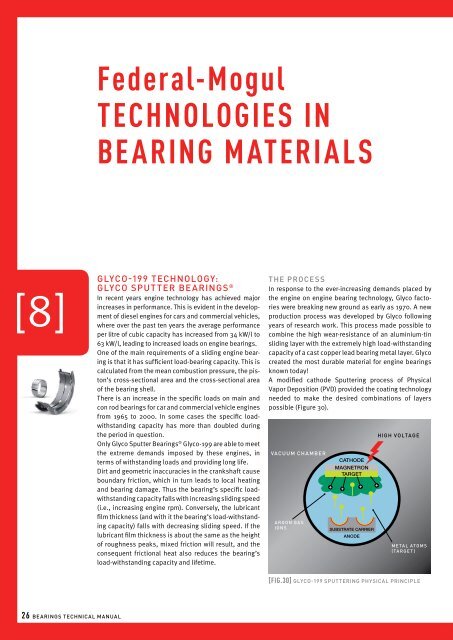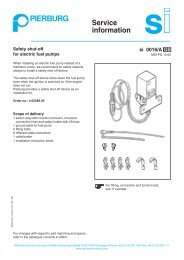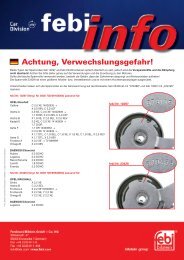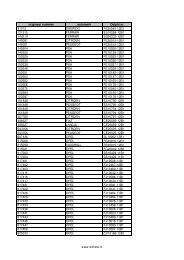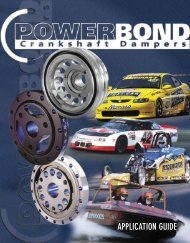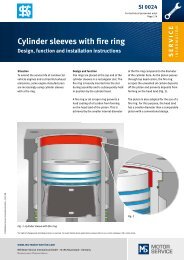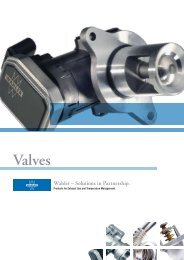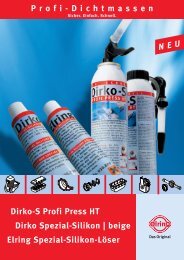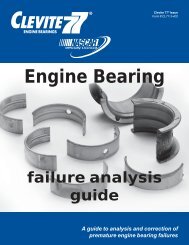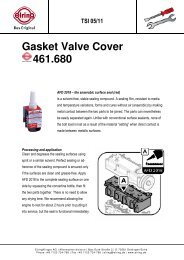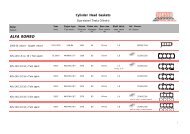EvEry bEaring you nEEd
EvEry bEaring you nEEd
EvEry bEaring you nEEd
You also want an ePaper? Increase the reach of your titles
YUMPU automatically turns print PDFs into web optimized ePapers that Google loves.
[8]<br />
Federal-Mogul<br />
technologies in<br />
bearing materials<br />
GLYCO-199 technology:<br />
GLYCO Sputter Bearings ®<br />
In recent years engine technology has achieved major<br />
increases in performance. This is evident in the development<br />
of diesel engines for cars and commercial vehicles,<br />
where over the past ten years the average performance<br />
per litre of cubic capacity has increased from 34 kW/l to<br />
63 kW/l, leading to increased loads on engine bearings.<br />
One of the main requirements of a sliding engine bearing<br />
is that it has sufficient load-bearing capacity. This is<br />
calculated from the mean combustion pressure, the piston’s<br />
cross-sectional area and the cross-sectional area<br />
of the bearing shell.<br />
There is an increase in the specific loads on main and<br />
con rod bearings for car and commercial vehicle engines<br />
from 1965 to 2000. In some cases the specific loadwithstanding<br />
capacity has more than doubled during<br />
the period in question.<br />
Only Glyco Sputter Bearings ® Glyco-199 are able to meet<br />
the extreme demands imposed by these engines, in<br />
terms of withstanding loads and providing long life.<br />
Dirt and geometric inaccuracies in the crankshaft cause<br />
boundary friction, which in turn leads to local heating<br />
and bearing damage. Thus the bearing’s specific loadwithstanding<br />
capacity falls with increasing sliding speed<br />
(i.e., increasing engine rpm). Conversely, the lubricant<br />
film thickness (and with it the bearing’s load-withstanding<br />
capacity) falls with decreasing sliding speed. If the<br />
lubricant film thickness is about the same as the height<br />
of roughness peaks, mixed friction will result, and the<br />
consequent frictional heat also reduces the bearing’s<br />
load-withstanding capacity and lifetime.<br />
The process<br />
In response to the ever-increasing demands placed by<br />
the engine on engine bearing technology, Glyco factories<br />
were breaking new ground as early as 1970. A new<br />
production process was developed by Glyco following<br />
years of research work. This process made possible to<br />
combine the high wear-resistance of an aluminium-tin<br />
sliding layer with the extremely high load-withstanding<br />
capacity of a cast copper lead bearing metal layer. Glyco<br />
created the most durable material for engine bearings<br />
known today!<br />
A modified cathode Sputtering process of Physical<br />
Vapor Deposition (PVD) provided the coating technology<br />
needed to make the desired combinations of layers<br />
possible (Figure 30).<br />
VACUUM CHAMBER<br />
Argon Gas<br />
Ions<br />
CATHODE<br />
MAGNETRON<br />
TARGET<br />
SUBSTRATE CARRIER<br />
ANODE<br />
HIGH VOLTAGE<br />
Metal Atoms<br />
(Target)<br />
[fig.30] Glyco-199 Sputtering physical principle<br />
In Sputtering, a dispenser cathode of an aluminium-tin alloy is<br />
bombarded by argon plasma, causing the aluminium and tin atoms<br />
to deposit as lining on the specially prepared engine bearings. The<br />
Physical Vapor Deposition (PVD) process produces an exceptionally<br />
even alloy matrix, offering outstanding resistance to wear and to<br />
very high loads. The structure of Glyco Sputter Bearings ® makes<br />
the reasons for their high performance clear. The bond between<br />
the die-cast leaded bronze bearing metal layer and the sliding<br />
surface is strengthened by an intermediate layer of pure nickel,<br />
which is circa 2 µm thick (Figure 31).<br />
ca. 16 µm<br />
ca. 2 µm<br />
0.2-0.3 mm<br />
[fig.31]<br />
Sputter Layer<br />
of Tin & Aluminium<br />
Nickel<br />
Inter-Layer<br />
CuPb22Sn<br />
Lead-bronze Layer<br />
Nickel prevents the diffusion of atoms between<br />
the Lead-bronze and the Sputter<br />
Commercial vehicle engines fitted with Glyco Sputter Bearings ®<br />
achieve lifetimes of one million km, and engine manufacturers<br />
are now working to increase this to one million miles.<br />
Computer-controlled processes incorporating high cleanliness<br />
and precision standards lead to uniform high quality in mass production.<br />
Under extreme loads, even minimal discrepancies can<br />
be detrimental to the bearing’s reliable functioning – therefore<br />
100% fault-free production is essential.<br />
Repair and running tips for<br />
GLYCO Sputter bearings ®<br />
The hardness of the Sputter layer gives the bearing extremely<br />
high wear resistance and high fatigue resistance. The Sputtered<br />
AISn20 layer is sensitive to the contamination of the lubricant oil<br />
with particles, water or alkaline elements, the last of which can<br />
get into the engine oil via anti-freeze in the coolant water.<br />
To ensure that engine repairs are carried out correctly, these Glyco<br />
Sputter Bearings ® characteristics must be taken into account.<br />
Under high loads the oil film thickness decreases, so that even<br />
very small contaminant particles can penetrate it. On the other<br />
hand, the hard Sputter layer’s high wear resistance means that it<br />
adapts more slowly to the unevenness of the crankshaft’s surface.<br />
As a consequence, the crankpins and the housing bores must be<br />
in optimum condition in terms of geometry and surface roughness.<br />
During running the loads can cause the housing bore to deform.<br />
The original bearing can adapt to this deformation during running,<br />
but when new bearings are installed the reduced play in the deformation<br />
zones can lead to the destruction of the lubrication film. For<br />
these reasons the housing bores must also be carefully finished.<br />
In comparison to conventional surfaces, the increased surface<br />
hardness of the layers of the Glyco Sputter Bearings ® reduces<br />
the capacity to bed-in contaminant particles. Accordingly, Glyco<br />
Sputter Bearings ® are, as a rule, composed of a bearing shell with<br />
a Sputter layer plus a bearing shell with a softer running surface.<br />
The Sputter shell is fitted in areas exposed to high loads, while<br />
the softer shell is used in the vicinity of the engine bearing,<br />
which is subject to lower load. The softer half of the bearing shell<br />
is more able than the Sputter layer to absorb the contaminant<br />
particles contained in the oil.<br />
This engineering solution has proved best in practice. Nevertheless,<br />
the careful cleaning of all engine parts and the lubrication<br />
system and also the utmost cleanliness when repairing and<br />
assembling the engine are vital prerequisites for successful<br />
maintenance. Any residual dirt must be removed by rinsing the<br />
stationary engine before the engine is started for the first time.<br />
Where the maximum permissible engine rpm is n max, the following<br />
running-in programme has been established:<br />
Step 1 1 min 1 /3<br />
Step 2 1 min 1 /4<br />
Step 3 1 min 1 /2<br />
Step 4 1 min 1 /3<br />
n max<br />
n max<br />
n max<br />
n max<br />
During running-in, the engine performance should not exceed<br />
15 to 20% of maximum load.<br />
26 Bearings Technical Manual<br />
27


